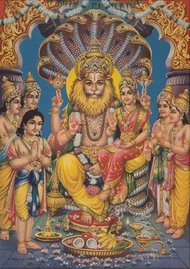Another useful reference in this context is Sri Thyagaraja Swami's Prahlada Bhakti Vijayam where Sadguru Thyagaraja portrays Lord Narasimha as his Abhimana Daivam Sri Rama in the Kriti Daya Rani Daya Rani. Interestingly, this work is devoid of the Ugra (violent) aspect of Lord Narasimha and focusses exclusively on Prahlada's Bhakti. The Krithi Kambadinda Vodadu Bandayo Narasimha, provides a very moving description of Lord Narasimhar emerging from the pillar to the rescue of his Bhakta, Prahlada.
Further references to Bhagavan Narasimha can be found in the Panchamruta Stotram of Lord Rama (cf: Harivamsha PuraNam). The Stotram begins with Ahobilam Narasimham Gatva Rama PratapavAn. It is important to note that this Stotram includes salutations of Lord Narasimha in Para, Vyuha, Vibhava, Archa and Antaryamitva forms. In particular, the line "Narayana Achyuta Nrisimho Namo Namaste" dwells on the Antaryamitva aspect of Lord Narasimhar and points to the fact that Narasimha is Achyutan personified. At the arrival of Lord Krishna during her Swayamvara, Rukmini exclaims "KalE Narasimha Narasimha", in
reference to the timely appearance of Lord Krishna, akin to that of
Lord Narasimha. The line Meena Krute... of the Venkateshwara Suprabatham dealing with the Dashavataram dwells on Bhagavan Narasimha as "Nrisimha VarNin".
The greatness of Bhagavan Narasimha is brilliantly described by Swami
Desikan in the KamasikAshtakam. This Stotram containing eight verses,
dwells on the Archa Murthy of Bhagavan Narasimhar seated in Yogic posture on the banks of the Vegavathi river. Bhagavan Narasimha is considered to have arrived at this Kshetram on his own accord and worship offered to him confers the seekers with the boon of fulfilling their desires. In the salutation "Tapaneeya RahasyaNAm Sara: KamAsikhA Hari:" Bhagavan Narasimhar is extolled as the secret of the (Purva and Uttara) Tapaneeya Upanishad of the AtharvaNa Vedam. This Upanishad contains a brilliant Gayathri Mantram in praise of Bhagavan Narasimha. Perhaps in keeping with the statement of Tapaneeya RahasyaNam, this Gayathri Mantram is not very well known and is seldom used in Homams.
Swami Desikan uses the description Adbhuta Kesari to salute Bhagavan
Narasimha. This salutation ties in very nicely with the reference "Narasimhavapu Sriman Keshava Purushottama" from the Vishnu Sahasranam.
The import of Swami Desikan's message is that the half-man-half lion was beautiful to look at. The beauty (Adbhuta) of Narasimhar was that he had manifested himself in every atom surrounding the Sabha of HiraNyakashipu in his anxiety to help Prahlada. Bhagavan Narasimha decided to reveal his omnipresence in this manner so that he could be found anywhere HiraNyan went looking for proof of His all-pervasiveness.
KamasikAshtakam dwells on the three eyes of Bhagavan Narasimhar (Sun, Moon and Agni). A benevolent glance of Lord Narasimhar is capable of curing anyone from the three kinds of illness (Adhyatmika, Adi Bhowdika and Adi Daivika).
The hands (competing with each other to destroy Hiranyan and grace Prahlada) and eyes of Bhagavan Narasimha simultaneously radiating compassion for Prahlada and striking terror in HiraNyan is beautifully brought out by Swami Desikan in the salutations Vikasvara Nakhasvarukshata: Hiranya Vakshasthalee and SatapatalabheeshaNe SarabasAttahasOtpateh, respectively.
This symbolizes the Pida Pariharam (for Bhaktas) and Pida Pradanam (for Dushtas) attributes of Bhagavan Narasimha. Further connections between
the Pida Pradanam and Pida Pariharam aspects of Bhagavan Narasimhar can be inferred from the Vishnu Sahasranamam salutation "ParitrANaya SadhUnAm VinAshayacha DushkritAm" with emphasis on ParitrANaya SadhUnAm, i.e., protection of Sajjanas. The destruction of evil is only a by product which results from the protection of the righteous.
Further indications of the Pida Pariharam and Pida Pradanam aspects of Bhagavan Narasimhar are evident from the fact that he is the only incarnation of Lord Narayana who is seen wearing his Padhukas constantly, i.e., he is ever willing and ready to rush to the succour of his Bhaktas.
The movement of Bhagavan Narasimhar in pursuit of HiraNyan is wonderfully captured by Swami Desikan's (Shardoola Vikridita meter)description in the KamasikAshtakam. Daya for Prahlada is described in the salutation SatApatala bheeshaNe.... DayE Danura Dimba DattastanAm. An identical salutation is used by Swami Desikan in the Daya Shatakam to describe the merciful nature of Lord Srinivasa. Perhaps this points to the connections between Bhagavan Narasimha and the Lord of Seven Hills. The concluding salutation (Tvayi Rakshati...) of the KamasikAshtakam refers to the ultimacy of Bhagavan Narasimhar. In this salutation, Swami Desikan states "When you have decided to protect someone where is the need for other protectors? If you have decided not to protect someone, of what use are other protectors?"
In the Ahirbudhnya Samhita (a Pancharatra Agama text), Ahirbudhnya conclusively establishes the all pervasiveness of Bhagavan Narasimha in the Mantra Raja Pada Stotram.
Lakshmi Narasimha Slokas
- karaavalambam -Sriivanshatakopa
- kaamaasikaashtakam
- Yoga Lakshmiinarasimha Suprabhaatam.
- Srii Lakshminrisimhaadi Suprabhaatam
- Runavimochana
- Nrusimhamangalam
- Nrisimhaashtakam
- Nrisimha Pancaamrutastotram
- Nrisimha Mangalam Ghatikachalam)
- Navanaarasimha Mangalaashaasanam
- Naryaneeyam - Narasimha Avataram
- Narasimha stuti
- Narasimha Stotram
- Narasimha Kavacham1
- Narasimha Kavacham
- Mattapalli Mangalaashtakam
- Mantraraajapadastotram.
- Lakshminrusimha Pancharatnam
- Lakshminrisimha ashtottarashatanama stotram
- Lakshmiinrusimhaprapatti1
- Lakshmiinrusimhaprapatti
- Lakshmiinrusimha Mangalaashaasanam
- Lakshmii Nrisimha Sahasranaamam.
- Karaavalambam Sankaracharaya
- Haryashtakam


